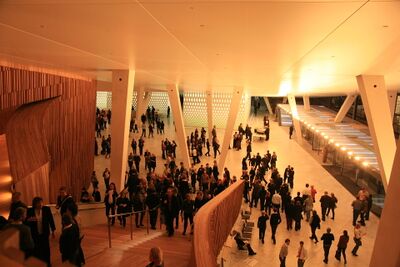The Guggenheim Effect
The Guggenheim Effect is named after the 1997 Guggenheim Museum, Bibao, Spain, where the museum helped transform the fortunes of the city. Prestigious performing arts centres and opera houses have since been built in the hope of reevoking the effect.
A single building can change an entire cityscape. Frank Gehry’s Guggenheim Museum put Bilbao on the world map, and was pivotal in the transformation of the northern Spanish city from a post-industrial conurbation in decline to a prosperous centre for the service industries. The museum was the first of a series of cultural, commercial and infrastructure developments, and such was the impact of the developments the Museum triggered, the phrase Guggenheim effect, or Bibao effect, has come to describe the influence of any new cultural centre that transforms its location.
Other cultural developments have attempted to trigger the Guggenheim effect: the Elbphilharmonie in Hamburg, by Herzog/de Meuron; the Taipei Performing Arts Center, by David Gianotten and Rem Koolhaas; the Peking Performing Arts Center, by Paul Andreu; the Grand Theatre Tianjin, by gmp; and the Grand Theatre Guangzhou, by Zaha Hadid. These developments have four factors in common:
- a central location
- they are near bodies of water
- they have innovative, but often less functional (or even impractical) architecture…
- …which is both provocative and spectacular.
These factors also apply to the Operahuset – the Opera House in Oslo, and Norway’s most important performing arts centre (Q10937). It is a 21st century opera house, having opened in 2008 and designed by the Norwegian architectural firm Snøhetta. Its architecture aims to combine the urban landmark, an opera house with the character of an urban monument, with an integration with nature. The roof of the building rises from ground level, forming a slope that is accessible to the public. The building is clad entirely in white Carrara marble and glass, completing the intended effect of an iceberg emerging from the sea of the Oslo fjord. Interior surfaces are covered in oak to bring warmth to spaces in contrast to the coolness of the white exterior, while the main auditorium is illuminated by a large oval crystal chandelier – all contributing to the feeling of a modern but opulent space.
The building itself is not only a home for the performing arts, it is also an artwork in its own right, and hosts visual artworks inside and out. She Lies is a sculpture constructed of stainless steel and glass panels by Monica Bonvicini, floating in the fjord, moving in response to tides and wind. A perforated wall panel in the lobby was designed by Olafur Eliasson, featuring hexagonal openings and illuminated from below and behind to create the illusion of melting ice. The main stage curtain is the work of Pae White who designed it to look like crumpled aluminium foil. The curtain from wool, cotton and polyester with a three-dimensional effect was manufactured by the German-based theatrical equipment company Gerriets GmbH, and measures 23m x 11m and weighs 500kg.
Plans for the opera house began in 1989, when the Norwegian Opera initiated a study to consider the creation of an independent opera house in Oslo. After the plans for the opera house were presented, there was an intense and time-consuming public debate about whether an opera house should be built in the city. Critics pointed to the level of costs, needs and architectural expression of the building, and this debate has continued after the building was started and opened.
The public, on the other hand, has embraced the theatrical and operatic event. The Oslo Opera’s attendance numbers have increased significantly since moving into the new opera house, to the point where all performances are sold out at the beginning of the season. The public and urban character of its architecture has also attracted many visitors who want to see and walk on the roof of the building, which invites pedestrians to climb up and enjoy the panoramic views of Oslo. The roof has also been the venue for several outdoor events, and the Oslo Opera House has won the culture award at the World Architecture Festival in Barcelona in October 2008, and the 2009 European Union Prize for Contemporary Architecture.
It has long been understood that cultural development can help underpin economic and social development. The Guggenheim effect is named after the Museum in Bibao that had a far greater impact than had been anticipated, and which governments have sought to repeat since then – sometimes with success, and sometimes not. Despite early criticisms, the Oslo Opera House has proved popular with audiences, locals and tourists, though whether it has in the end been value for money is a more subjective judgement.


